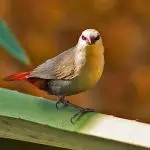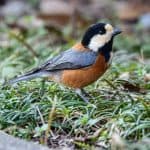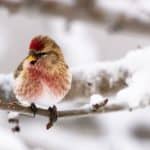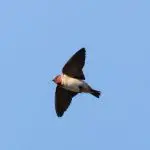Common Name: Red-throated Pipit
Scientific Name: (Anthus cervinus)| Size | Diet | Range in Hawaii | Status in Hawaii |
|---|---|---|---|
| 6 in. - 7 in. | beetles, grasshoppers, and flies | Unkown | Least Concern |
The Red-throated Pipit (Anthus cervinus) is a unique and fascinating bird species that is native to parts of Europe and Asia. With its distinctive brown and white plumage and striking red throat patch, this bird is a beloved sight in its natural habitat. However, the species is also known to make appearances as a non-breeding visitor and vagrant in Hawaii, where it is a rare and exciting sighting for birdwatchers.
In this article, we’ll explore the fascinating world of the Red-throated Pipit, its unique adaptations, and behavior in the wild.
Red-throated Pipit
Appearance
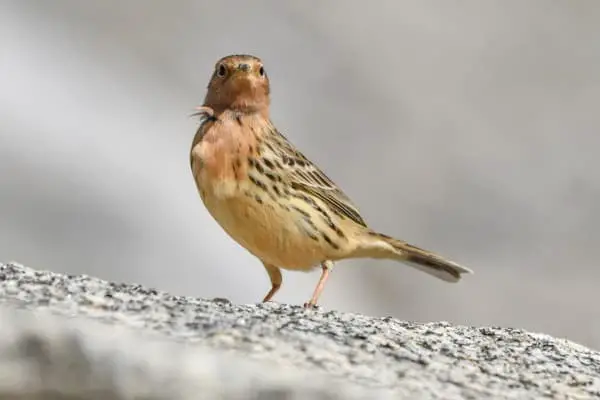
The Red-throated Pipit is a visually captivating bird with distinct features. It measures approximately 6-7 inches in length, making it a relatively small passerine species. Its plumage showcases a blend of earthy tones, including sandy brown and streaks of black.
What sets it apart is the striking red throat patch that gives the species its name. This vibrant accent adds a splash of color to its overall appearance.
Diet
This species has a versatile palate, feeding on a diverse array of food sources. During the breeding season, their diet primarily consists of insects such as beetles, grasshoppers, and flies. They skillfully forage on the ground, searching for small invertebrates hidden amidst grasses and low vegetation.
However, outside of the breeding season, their diet undergoes a notable shift. The Red-throated Pipit becomes more omnivorous, incorporating a variety of seeds, grains, and berries into its menu.
Nesting
These birds typically build their nests on the ground, creating a shallow depression lined with grass, moss, and other plant materials. This choice of location offers protection and camouflage against potential predators.
During the breeding season, which usually occurs in the summer months, the female Red-throated Pipit lays a clutch of eggs within the nest. The clutch size typically consists of 3-6 eggs, which are pale in color with brown speckles. The female takes on the primary responsibility of incubating the eggs, while the male assists by bringing food to the nest.
Once the eggs hatch, both parents tirelessly work together to feed and care for the chicks. They diligently search for insects and other small invertebrates to provide a protein-rich diet for their growing offspring. As the chicks mature, they gradually develop their flight feathers and eventually fledge from the nest.
Behavior
One notable behavior of the Red-throated Pipit is its distinctive flight pattern. During flight, they showcase a series of undulating wingbeats, alternating with short glides. This flight style adds to their charm and can be observed as they move from one foraging area to another.
Red-throated Pipits are also known for their melodious songs, especially during the breeding season. Males perch atop low vegetation or trees to deliver their intricate songs, which consist of a combination of whistles, trills, and chirps. These beautiful vocalizations serve as a means of communication and courtship.
During migration, Red-throated Pipits undertake impressive long-distance journeys, traveling between their breeding and wintering grounds. Their ability to navigate across vast distances showcases their innate migratory instincts and adaptability to different habitats.
Habitat

These adaptable birds are known to inhabit diverse landscapes, showcasing their ability to thrive in different environments. During the breeding season, Red-throated Pipits prefer open grasslands, meadows, and tundra regions. They are commonly found in areas with short vegetation, such as Arctic tundra, alpine meadows, and marshy habitats.
In their non-breeding range, they can be spotted in agricultural fields, grassy plains, scrublands, and even sandy coastal areas. Additionally, during migration, Red-throated Pipits traverse various habitats, including coastal areas, wetlands, and open woodlands, as they journey between their breeding and wintering grounds.
Range
The Red-throated Pipit (Anthus cervinus) is a non-breeding visitor to Hawaii, making it a vagrant species in the region. While it typically breeds across northern Eurasia and Alaska, and winters in northern Africa, India, Southeast Asia, and the Philippine Islands, its presence in Hawaii is considered irregular. Only two recorded instances have been documented, both from Kure in the Northwestern Hawaiian Islands.
Conservation Status
The Red-throated Pipit is currently classified as a species of “Least Concern” by the International Union for Conservation of Nature (IUCN). This means that, at present, there is no immediate threat to the overall population of these birds.
Interesting Facts
1. Mimetic behavior
Red-throated Pipits are known to exhibit mimetic behavior, imitating the vocalizations of other bird species. They can incorporate elements of other birds’ songs into their own repertoire, adding complexity and diversity to their vocalizations.
2. Distinctive flight display
During courtship, male Red-throated Pipits perform an elaborate flight display called “parachuting.” They fly high in the air, then suddenly spread their wings and glide down in a parachute-like motion, showcasing their agility and attracting potential mates.
3. Precocial chicks
Red-throated Pipit chicks are precocial, which means they are relatively independent and mobile soon after hatching. They are able to leave the nest shortly after birth and begin foraging for themselves, although they still rely on their parents for protection and guidance.
4. Hybridization
Red-throated Pipits occasionally hybridize with other pipit species, such as the Tree Pipit (Anthus trivialis) and the Olive-backed Pipit (Anthus hodgsoni), where their breeding ranges overlap. These hybrid offspring may exhibit intermediate characteristics between the parent species.
5. Distinctive flight call
In addition to their melodious songs, Red-throated Pipits have a distinctive flight call. During their aerial movements, they emit a high-pitched “tsip” or “see-see” sound, which helps maintain contact with other individuals in their flock.
Frequently Asked Questions
1. How can I attract Red-throated Pipits to my garden?
Attracting Red-throated Pipits to a garden is challenging, as they are primarily open-habitat birds. Creating a habitat with open grassy areas and providing a water source may increase the chances of attracting them. However, it is important to note that their presence will depend on their local distribution and migration patterns.
2. How long do Red-throated Pipits live?
The lifespan of Red-throated Pipits in the wild is not extensively studied, but they can live for several years. Ringing and banding studies have shown instances of individuals being recaptured and identified after multiple years, suggesting a reasonable lifespan for these birds.
3. How far do Red-throated Pipits migrate?
Red-throated Pipits undertake long-distance migrations, traveling thousands of kilometers between their breeding and wintering grounds. The exact distance covered can vary depending on the population and specific migration routes taken, but they can migrate from northern Eurasia or Alaska to wintering areas in northern Africa, India, Southeast Asia, and the Philippine Islands.
4. Do Red-throated Pipits engage in mobbing behavior?
Yes, Red-throated Pipits are known to engage in mobbing behavior. When they detect a potential predator, such as a bird of prey or other threat, they may gather in a group and vocalize loudly, swooping and diving towards the intruder to drive it away and protect their nest or young.
5. Can Red-throated Pipits be kept as pets?
No, it is not recommended to keep Red-throated Pipits or any other wild birds as pets. They are wild animals that require specific natural habitats, proper nutrition, and social interaction with their own species. Captivity can lead to significant stress and health problems for these birds.

